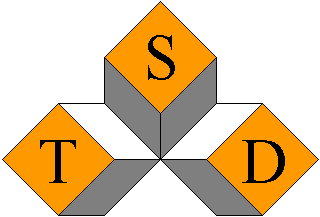Computational linguistics is an interdisciplinary field concerned with the computational modelling of natural language, as well as the study of appropriate computational approaches to linguistic questions. In general, computational linguistics draws upon linguistics, computer science, artificial intelligence, math, logic, philosophy, cognitive science, cognitive psychology, psycholinguistics, anthropology and neuroscience, among others.

Natural language processing (NLP) is a subfield of linguistics, computer science, and artificial intelligence concerned with the interactions between computers and human language, in particular how to program computers to process and analyze large amounts of natural language data.
Speech synthesis is the artificial production of human speech. A computer system used for this purpose is called a speech computer or speech synthesizer, and can be implemented in software or hardware products. A text-to-speech (TTS) system converts normal language text into speech; other systems render symbolic linguistic representations like phonetic transcriptions into speech.
Natural-language understanding (NLU) or natural-language interpretation (NLI) is a subtopic of natural-language processing in artificial intelligence that deals with machine reading comprehension. Natural-language understanding is considered an AI-hard problem.

Peter Norvig is an American computer scientist. He is a director of research at Google Inc., and used to be its director of search quality.
The term programming domain is mostly used when referring to domain-specific programming languages. It refers to a set of programming languages or programming environments that were written specifically for a particular domain, where domain means a broad subject for end users such as accounting or finance, or a category of program usage such as artificial intelligence or email. Languages and systems within a single programming domain would have functions common to the domain and may omit functions that are irrelevant to a domain.
A blackboard system is an artificial intelligence approach based on the blackboard architectural model, where a common knowledge base, the "blackboard", is iteratively updated by a diverse group of specialist knowledge sources, starting with a problem specification and ending with a solution. Each knowledge source updates the blackboard with a partial solution when its internal constraints match the blackboard state. In this way, the specialists work together to solve the problem. The blackboard model was originally designed as a way to handle complex, ill-defined problems, where the solution is the sum of its parts.
In the history of artificial intelligence, an AI winter is a period of reduced funding and interest in artificial intelligence research. The term was coined by analogy to the idea of a nuclear winter. The field has experienced several hype cycles, followed by disappointment and criticism, followed by funding cuts, followed by renewed interest years or decades later.
The following outline is provided as an overview of and topical guide to artificial intelligence:

Stephen Malvern Omohundro is an American computer scientist whose areas of research include Hamiltonian physics, dynamical systems, programming languages, machine learning, machine vision, and the social implications of artificial intelligence. His current work uses rational economics to develop safe and beneficial intelligent technologies for better collaborative modeling, understanding, innovation, and decision making.
Daniel L. Weinreb was an American computer scientist and programmer, with significant work in the environment of the programming language Lisp.

Jaime Guillermo Carbonell was a computer scientist who made seminal contributions to the development of natural language processing tools and technologies. His extensive research in machine translation resulted in the development of several state-of-the-art language translation and artificial intelligence systems. He earned his B.S. degrees in Physics and in Mathematics from MIT in 1975 and did his Ph.D. under Dr. Roger Schank at Yale University in 1979. He joined Carnegie Mellon University as an assistant professor of computer science in 1979 and lived in Pittsburgh from then. He was affiliated with the Language Technologies Institute, Computer Science Department, Machine Learning Department, and Computational Biology Department at Carnegie Mellon.
Natural-language user interface is a type of computer human interface where linguistic phenomena such as verbs, phrases and clauses act as UI controls for creating, selecting and modifying data in software applications.
Speech translation is the process by which conversational spoken phrases are instantly translated and spoken aloud in a second language. This differs from phrase translation, which is where the system only translates a fixed and finite set of phrases that have been manually entered into the system. Speech translation technology enables speakers of different languages to communicate. It thus is of tremendous value for humankind in terms of science, cross-cultural exchange and global business.

Text, Speech and Dialogue (TSD) is an annual conference involving topics on natural language processing and computational linguistics. The meeting is held every September alternating in Brno and Pilsen, Czech Republic.

Cynthia Solomon is an American computer scientist known for her work in artificial intelligence (AI) and popularizing computer science for students. She is a pioneer in the fields of artificial intelligence, computer science, and educational computing. While working as a researcher at Massachusetts Institute of Technology (MIT), Dr. Solomon took it upon herself to understand and program in the programming language Lisp. As she began learning this language, she realized the need for a programming language that was more accessible and understandable for children. Throughout her research studies in education, Dr. Solomon worked full-time as a computer teacher in elementary and secondary schools. Her work has mainly focused on research on human-computer interaction and children as designers. While working at Bolt, Beranek and Newman, she worked with Wally Feurzeig and Seymour Papert, to create the first programming language for children, named Logo. The language was created to teach concepts of programming related to Lisp. Dr. Solomon has attained many accomplishments in her life such as being the vice president of R&D for Logo Computer Systems, Inc., when Apple Logo was developed and was the Director of the Atari Cambridge Research Laboratory. Dr. Solomon worked on the program committee of Constructing Modern Knowledge and the Marvin Minsky Institute for Artificial Intelligence in 2016. Further, she has published many writings based on research in the field of child education and technology in the classroom. Dr. Solomon has conducted workshops in elementary schools, high schools, and colleges regarding academic research and writing. She continues to contribute to the field by speaking at conferences and working with the One Laptop per Child Foundation.
The following outline is provided as an overview of and topical guide to natural language processing:
Inductive programming (IP) is a special area of automatic programming, covering research from artificial intelligence and programming, which addresses learning of typically declarative and often recursive programs from incomplete specifications, such as input/output examples or constraints.